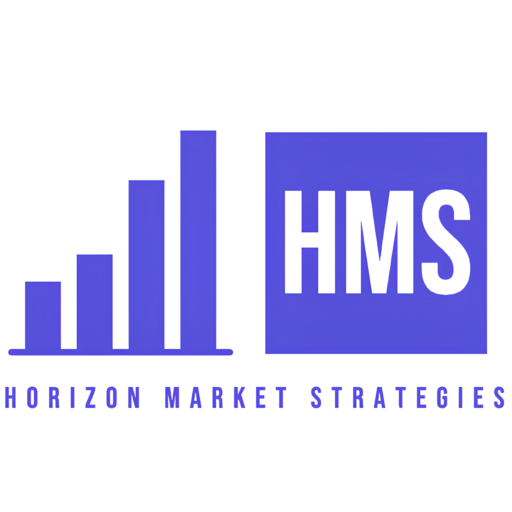Chemical Market Outlook: Size, Share, Trends & Growth Analysis (2024-2029)
The report covers a comprehensive analysis segmented by Product Type (Basic Chemicals, Specialty Chemicals, Fine Chemicals), by Raw Materials (Petrochemicals, Renewable Chemicals, Inorganic Chemicals, Others), by End- User (Pharmaceuticals, Agriculture, Automotive, Construction, Electronics), by Geography (North America, South America, Asia Pacific, Europe, The Middle East, Africa).
Chemical Market Snapshot
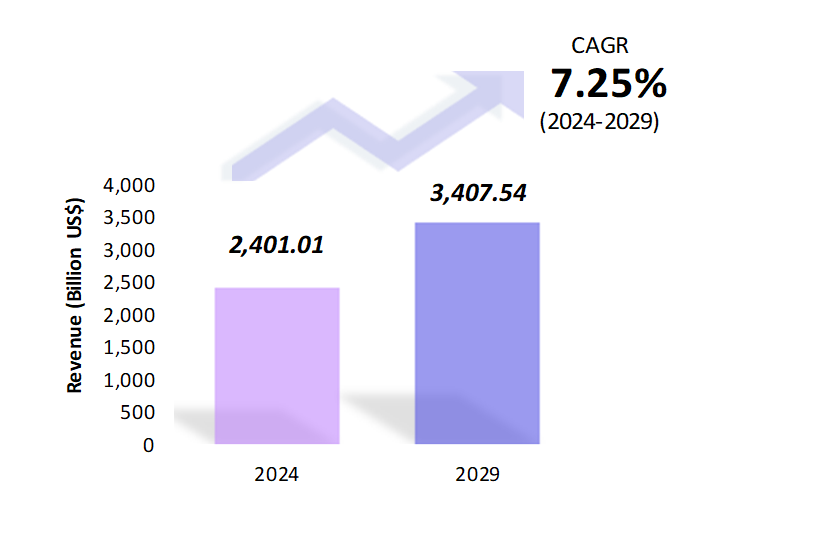
Chemical Market Overview
The global chemical market is estimated to be at $2401.01 Bn in 2024 and is anticipated to reach $3407.54 Bn in 2029. The global chemical market is registering a CAGR of 7.25% during the forecast period 2024-2029. The global chemical market is a pivotal sector underpinning diverse industries worldwide, including manufacturing, agriculture, healthcare, and consumer goods. With a vast and ever-expanding market size, it encompasses a broad spectrum of products ranging from basic chemicals such as petrochemicals and industrial gases to specialty chemicals like pharmaceuticals, electronic chemicals, and advanced polymers.
This market is driven by several key factors, including industrialization, urbanization, population growth, and technological advancements. Emerging economies in regions like Asia Pacific, Latin America, and Africa are witnessing robust growth in chemical consumption due to rapid industrial development and increasing consumer demand.
Moreover, technological innovations in green chemistry, biotechnology, and nanotechnology are driving product development, efficiency improvements, and sustainability initiatives across the industry.
However, the chemical market faces significant challenges, including stringent regulatory requirements, volatile raw material prices, geopolitical uncertainties impacting trade dynamics, and the imperative to adopt sustainable practices.
Companies in this sector must navigate these challenges adeptly while seizing opportunities for growth and innovation in a competitive global marketplace. Strategic investments in research and development, along with a focus on regulatory compliance and sustainability, are crucial for maintaining market competitiveness and meeting evolving consumer and industrial demands effectively.
Chemical Market Coverage
| Historical & Forecast Period | 2018-2029 |
| Base Year | 2023 |
| Forecast Period | 2024-2029 |
| Units | Billion US$ |
| Segments | Product Type, Raw Materials, End- User |
| Geographies | North America, South America, Asia Pacific, Europe, The Middle East, Africa |
| Key Vendors | BASF Group, The Dow Chemical Co., Dupont De Nemours, Inc., Saudi Basic Industries Corp. (SABIC), Exxon Mobil Corp. |
Key Geographies of Chemical Market, 2023
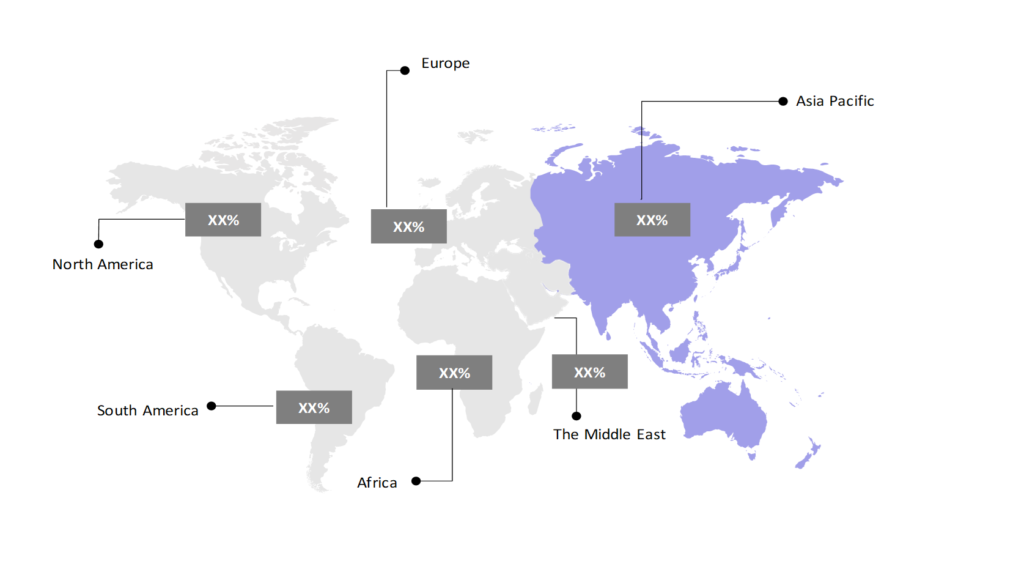
Porter’s 5 Forces Analysis of Chemical Market

Chemical Market Trends
The chemical market is currently navigating a dynamic landscape characterized by technological advancements, regulatory shifts, and evolving consumer preferences.
A significant trend is the increasing emphasis on sustainability and green chemistry, driven by both regulatory pressures and consumer demand for environmentally friendly products. Companies are investing heavily in renewable feedstocks, recycling technologies, and processes that reduce carbon footprints. For instance, in February 2024, BASF launched its Ccycled products. These products are manufactured using feedstock derived from plastic waste through BASF’s ChemCycling process. This innovation reduces reliance on fossil resources by incorporating recycled materials into conventional production, aligning with regulatory pressures and consumer demand for more environmentally friendly products.
Digital transformation is another critical trend reshaping the chemical industry. The adoption of advanced analytics, artificial intelligence, and IoT is enhancing operational efficiency, optimizing supply chains, and enabling predictive maintenance. This technological integration is crucial for maintaining a competitive advantage in a highly volatile market. For instance, Dow has implemented advanced analytics and artificial intelligence in its operations. Dow has been using these technologies to enhance operational efficiency, optimize supply chains, and enable predictive maintenance across its facilities. The company utilizes AI-driven predictive maintenance to anticipate equipment failures before they occur, reducing downtime and maintenance costs, and thereby maintaining a competitive edge in the market.
Geopolitical factors and trade dynamics continue to impact the chemical market, influencing raw material availability and pricing. The ongoing trade tensions and economic uncertainties are prompting companies to diversify their supply chains and explore regional markets to mitigate risks.
In addition, there appears to be a movement in favor of specialty chemicals due to their greater margins and use in a variety of sectors, including electronics, agriculture, and healthcare. Mergers and acquisitions are being prompted by this transition as businesses look to expand their product lines and market share.
All things considered, the chemical industry is changing into a more specialized, technologically sophisticated, and sustainable environment, and businesses need to be adaptable and creative to survive.
Chemical Market Driving Factors
Economic expansion and industrialization, which impact many industries including consumer products, manufacturing, construction, and agriculture, are the main drivers of the demand for chemicals. The chemical market is growing due to the growing need for chemicals in industrial operations, consumer goods, and infrastructure projects.
As urbanization and population increase, so does the demand for chemicals used in construction materials, infrastructure projects, and consumer goods like detergents, personal care items, and packaging. The chemical market benefits from urbanization, which boosts the need for chemicals in transportation, water treatment, and urban infrastructure development. For instance, BASF, a chemical company, has been actively involved in providing construction chemicals for various infrastructure projects in India, including the DMIC. These chemicals enhance the durability and performance of construction materials, ensuring the longevity and sustainability of the infrastructure.
New products, procedures, and uses in the chemical industry are the result of technological advancement. The manufacture of more effective, high-performing, and sustainable chemicals has been made possible by advances in green chemistry, biotechnology, and nanotechnology. This has increased market rivalry and growth.
The market for sustainable and eco-friendly chemicals is driven by strict environmental legislation as well as sustainability initiatives. Green chemicals and renewable resources are in high demand due to regulations designed to minimize emissions, improve energy efficiency, and minimize waste. These regulations also encourage sustainable industrial practices.
There is a growing demand for specialty chemicals used in niche applications such as specialty polymers, electronics, coatings, and pharmaceuticals. As companies seek innovative solutions to meet specific performance requirements and regulatory standards, specialty chemicals become more significant, offering higher margins, and added value compared to commodity chemicals.
The demand for chemicals is driven by globalization and the exploration of new markets, particularly in areas that are quickly industrializing and developing. To meet the rising demand in sectors like consumer goods, electronics, automotive, and construction, multinational chemical corporations are extending their footprint in emerging economies. This is causing the industry to grow and become more diverse.
The profitability and competitiveness of the chemical industry are significantly influenced by the prices of energy and feedstock, including petrochemicals, natural gas, and crude oil. Fluctuations in energy prices and feedstock costs affect production expenses, product pricing, and investment decisions, shaping market dynamics and competitiveness within the industry.
Chemical Market Challenges
The chemical market faces several significant challenges that impact its growth and operational efficiency. These challenges include regulatory compliance, sustainability pressures, market volatility, technological adaptation, and geopolitical uncertainties.
With increasing emphasis on sustainability, chemical companies are under pressure to reduce their environmental footprint. This includes cutting greenhouse gas emissions, reducing waste, and using renewable feedstocks.
The chemical market is highly susceptible to fluctuations in raw material prices and demand. Prices of key feedstocks like crude oil and natural gas can be highly volatile, affecting production costs and profitability. The COVID-19 pandemic, for example, disrupted supply chains and led to significant demand fluctuations, challenging companies to adapt quickly.
While technological advancements offer opportunities, they also pose challenges in terms of adaptation and integration. Implementing advanced analytics, AI, and IoT requires significant investment and expertise. Companies that fail to keep pace with technological changes risk falling behind competitors who leverage these innovations effectively.
Geopolitical tensions and trade wars can disrupt supply chains and impact market stability. For example, the trade tensions between the U.S. and China have led to tariffs on chemical products, creating uncertainty and affecting international trade dynamics.
Navigating these challenges requires strategic planning, investment in innovation, and agility to adapt to changing market conditions.
Chemical Market – Key Industry News
- The start of Dow Inc.’s propylene glycol (PG) capacity expansion at its integrated manufacturing facility in Map Ta Phut, Rayong, Thailand, was announced in May 2024. The PG capacity is increased by 80,000 tons annually by this low capital intensity, high return investment, raising the annual total output to 250,000 tons. The Dow Map Ta Phut PG production facility is now the biggest of its kind in the Asia Pacific area thanks to its development.
- In April 2024, BASF, SABIC, and Linde inaugurated the world’s first demonstration plant for large-scale electrically heated steam cracking furnaces at BASF’s Verbund site in Ludwigshafen, Germany. This was a joint agreement signed in March 2021 by the three companies to develop and demonstrate innovative solutions for electrically heated steam cracking furnaces.
- In the United States, BASF introduced its Ccycled line of goods in February 2024.From its BASF TotalEnergies Petrochemicals facility in Port Arthur, Texas, the company offers customers ISCC+ certified advanced recycled building blocks by utilizing its ChemCycling technology. By integrating recycled material into traditional production, this novel approach lessens dependency on fossil fuels.
Chemical Market Competitive Landscape
The competitive landscape of the chemical market is characterized by intense rivalry among global and regional players vying for market share across diverse segments. Key competitive factors include technological innovation, product differentiation, pricing strategies, and sustainability initiatives.
Global chemical giants such as BASF Group, Dow Chemical Co., and Dupont De Nemours, Inc. dominate the market with extensive product portfolios spanning basic chemicals, specialty chemicals, and advanced materials. These companies leverage economies of scale, robust R&D capabilities, and global supply chain networks to maintain competitive advantage.
Regional players often focus on niche markets or specific geographic regions, offering specialized products tailored to local demands and regulatory requirements. They compete by emphasizing customer service, agility in responding to market trends, and flexibility in production capabilities.
Technological innovation plays a pivotal role, with advancements in green chemistry, biotechnology, and digitalization reshaping product development and operational efficiencies. Companies that lead in adopting sustainable practices, reducing environmental impact, and complying with stringent regulations are poised for long-term competitiveness. Godrej Industries has diversified into various segments such as agriculture, consumer goods, chemicals, and real estate. In the chemicals segment, they produce and supply a range of specialty chemicals including oleochemicals, surfactants, and performance chemicals. These chemicals cater to specific industrial needs and are tailored to meet local market demands.
In general, the competitiveness of the chemical market depends on ongoing innovation, strategic alliances, and adaptability to changing consumer demands and local and international regulatory environments.
Chemical Market Company Share Analysis, 2023 (%)
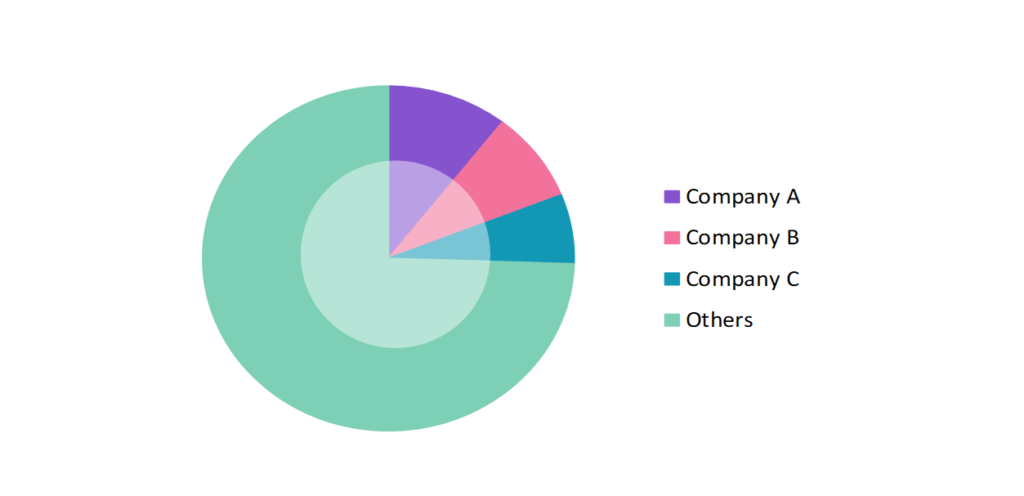
Chemical Market – Key Companies
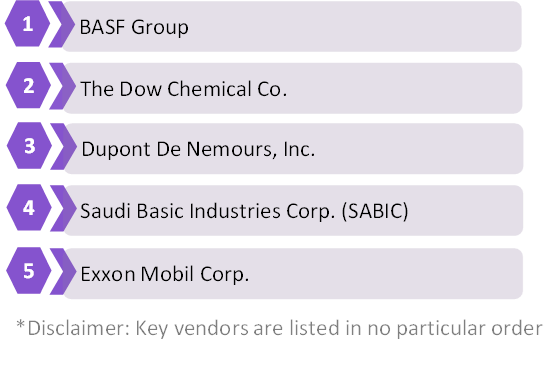
Reason to Buy from us

Table of Contents
| 1. Introduction |
|---|
| 1.1. Research Methodology |
| 1.2. Scope of the Study |
| 2. Market Overview / Executive Summary |
| 2.1. Global Chemical Market (2018 – 2022) |
| 2.2. Global Chemical Market (2023 – 2029) |
| 3. Market Segmentation |
| 3.1. Global Chemical Market by Product Type |
| 3.1.1. Basic Chemicals |
| 3.1.2. Specialty Chemicals |
| 3.1.3. Fine Chemicals |
| 3.2. Global Chemical Market by Raw Materials |
| 3.2.1. Petrochemicals |
| 3.2.2. Renewable Chemicals |
| 3.2.3. Inorganic Chemicals |
| 3.2.4. Others |
| 3.3. Global Chemical Market by End-User |
| 3.3.1. Pharmaceuticals |
| 3.3.2. Agriculture |
| 3.3.3. Automotive |
| 3.3.4. Construction |
| 3.3.5. Electronics |
| 4. Regional Segmentation |
| 4.1. North America |
| 4.1.1. The U.S |
| 4.1.2. Canada |
| 4.1.3. Mexico |
| 4.2. South America |
| 4.2.1. Brazil |
| 4.2.2. Argentina |
| 4.2.3. Colombia |
| 4.2.4. Chile |
| 4.2.5. Rest of South America |
| 4.3. Asia Pacific |
| 4.3.1. China |
| 4.3.2. India |
| 4.3.3. Japan |
| 4.3.4. South Korea |
| 4.3.5. Rest of Asia Pacific |
| 4.4. Europe |
| 4.4.1. UK |
| 4.4.2. Germany |
| 4.4.3. Italy |
| 4.4.4. France |
| 4.4.5. Spain |
| 4.4.6. Rest of Europe |
| 4.5. The Middle East |
| 4.5.1. Turkey |
| 4.5.2. UAE |
| 4.5.3. Saudi Arabia |
| 4.5.4. Rest of the Middle East |
| 4.6. Africa |
| 4.6.1. Egypt |
| 4.6.2. South Africa |
| 4.6.3. Rest of Africa |
| 5. Value Chain Analysis of the Global Chemical Market |
| 6. Porter Five Forces Analysis |
| 6.1. Threats of New Entrants |
| 6.2. Threats of Substitutes |
| 6.3. Bargaining Power of Buyers |
| 6.4. Bargaining Power of Suppliers |
| 6.5. Competition in the Industry |
| 7. Trends, Drivers, and Challenges Analysis |
| 7.1. Market Trends |
| 7.1.1. Market Trend 1 |
| 7.1.2. Market Trend 2 |
| 7.1.3. Market Trend 3 |
| 7.2. Market Drivers |
| 7.2.1. Market Driver 1 |
| 7.2.2. Market Driver 2 |
| 7.2.3. Market Driver 3 |
| 7.3. Market Challenges |
| 7.3.1. Market Challenge 1 |
| 7.3.2. Market Challenge 2 |
| 7.3.3. Market Challenge 3 |
| 8. Regulatory Landscape |
| 9. Competitive Landscape |
| 9.1. BASF Group |
| 9.2. The Dow Chemical Co. |
| 9.3. Dupont De Nemours, Inc. |
| 9.4. Saudi Basic Industries Corp |
| 9.5. Exxon Mobil Corp. |
| 9.6. Company 6 |
| 9.7. Company 7 |
| 9.8. Company 8 |
| 9.9. Company 9 |
| 9.10. Company 10 |
Chemical Market – Frequently Asked Questions (FAQs)
What is the current size of the global chemical market?
The market size for the global chemical market in 2024 is $2401.01 Bn.
Who are the major vendors in the global chemical market?
The major vendors in the global chemical market are BASF Group, The Dow Chemical Co., Dupont De Nemours, Inc., Saudi Basic Industries Corp. (SABIC), Exxon Mobil Corp.
Which segments are covered under the global chemical market segments analysis?
This report offers in-depth insights into each product type, raw materials, end- user.
